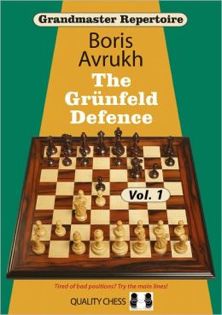GM Repertoire 8
The Grunfeld Defense: Volume 1
Boris Avrukh

Grandmaster Boris Avrukh made a big name for himself with his two-volume set on a White repertoire with 1.d4 (GM Rep: 1.d4). In those books he mixed theoretical acumen with the discovery of a number of new ideas, which made those books must owns for fans of 1.d4.
Now hes moved his attention to creating a Black repertoire vs. 1.d4 via the Grunfeld Defense, which encompasses two volumes. In the first he gives an in-depth look at 1.d4 Nf6 2.c4 g6 3.f3, lines where White fianchettos his light-squared Bishop (g3), and the following main lines starting with 1.d4 Nf6 2.c4 g6 3.Nc3 d5:
* 4.e3 Bg7
* 4.Bf4
* 4.Bg5
* 4.Nf3 Bg7 5.Bg5 Ne4
* 4.Nf3 Bg7 5.Qb3 dxc4 6.Qxc4 0-0 7.e4 Nc6
In the second volume he concentrates on main lines from 1.d4 Nf6 2.c4 g6 3.Nc3 d5 4.cxd5 Nxd5 5.e4 (he also looks at 5.Nf3, 5.Na4, 5.Bd2, and 5.g3) 5… Nxc3 6.bxc3 Bg7.
The first thing that came to my mind was his 1.d4 repertoire for White, where he recommended the Financhetto Variation for White, saying it offered good chances of a slight pull for the first player. How would he deal with playing the other side in this Black repertoire book? In The Grunfeld Defence Volume 1, the table of contents gives 1.d4 Nf6 2.c4 g6 3.g3 d5 4.cxd5 Nxd5 5.e4 Nb6 as the line he recommends. However, when I turned to the section in question, I found that he didnt recommend this at all! Instead, he went for 1.d4 Nf6 2.c4 g6 3.g3 c6. Typos are unavoidable (Ive personally discovered that in my own books), but the one thing you dont want to do is create a huge typo in the Table of Contents. Nevertheless, though its annoying, it doesnt detract from the books value. Of course, 3… c6 isnt very exciting, but its very, very solid. …
Both books (his 1.d4 repertoire for White and his Grunfeld repertoire for Black) point to 4.Nf3 d5 5.b3 Bg7 6.Bg2 0-0 7.0-0 dxc4 8.bxc4 c5 9.Bb2 as being critical. In GM REP: 1.d4 he views 9 …cxd4 as the key line (though he mentions 9… Qb6 as a “serious alternative to the main line), but in his Grunfeld book he only gives 9… Qb6. Clearly he found some new ideas for Black. Continuing to follow both books, we get 10.Qb3 and now GM REP: 1.d4 gives 10 …Nfd7 (“Blacks first choice according to theory), though it also mentions 10… Ne4 11.e3 Nc6 saying this might well be a better try than the more usual 11 …cxd4. However, he follows 11… Nc6 up with, “In this case White can force favorable simplifications with 12.Ne5 Nd6 13.Nxc6 bxc6 14.dxc5 Qxc5 15.Bxg7 Kxg7 16.Nd2, retaining some pressure.
Fair enough, but in the Grunfeld book, his main line is 10.Qb3 Ne4 11.e3 Nc6 12.Ne5 Nd6 13.Nxc6 (he also gives 13.Nd2 but it seems to be harmless) 13… bxc6 14.dxc5 Qxc5 15.Bxg7 Kxg7 16.Nd2 and now he writes: “In my earlier book I stopped at this position, considering it slightly favorable for White. However, it was tested at the recent Olympiad: 16 …Be6 17.Rfc1 Rab8 18.Qd3 Rfc8 19.Nb3. This occurred in Laznicka – Svidler, Khanty-Mansiysk (ol) 2010, and now I found the following improvement: 19 …Qb4 N Avrukh goes on to prove that Blacks completely equal.
As always, Avrukh takes all known theory and then fights to find what he deems to be the most critical lines. Having done that, he analyzes it to death and in the process comes up with an enormous amount of new ideas, most of which he happily publishes!
Both volumes of Avrukhs The Grunfeld Defense are wonderful, and any Grunfeld aficionado will grab these puppies as fast as he can. However, I also feel that anyone that plays 1.d4 will also be forced to buy these books.
Another magnificent job by Avrukh if you play either side of this opening, why arent these books heading from the Quality Chess storage to your bookshelf right now?
